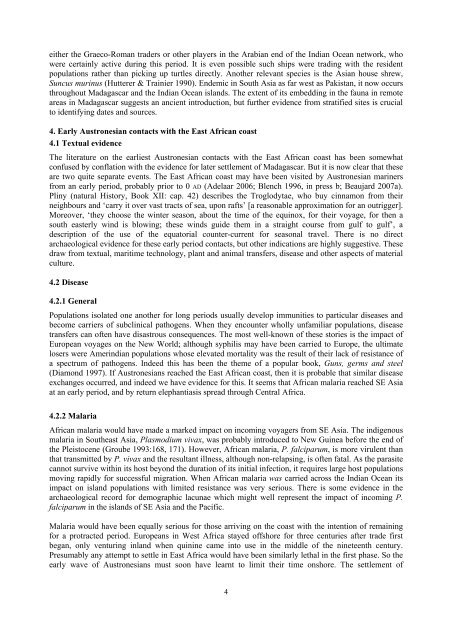Paper for Cambridge 2007 proceedings submit.pdf - Roger Blench
Paper for Cambridge 2007 proceedings submit.pdf - Roger Blench
Paper for Cambridge 2007 proceedings submit.pdf - Roger Blench
Create successful ePaper yourself
Turn your PDF publications into a flip-book with our unique Google optimized e-Paper software.
either the Graeco-Roman traders or other players in the Arabian end of the Indian Ocean network, who<br />
were certainly active during this period. It is even possible such ships were trading with the resident<br />
populations rather than picking up turtles directly. Another relevant species is the Asian house shrew,<br />
Suncus murinus (Hutterer & Trainier 1990). Endemic in South Asia as far west as Pakistan, it now occurs<br />
throughout Madagascar and the Indian Ocean islands. The extent of its embedding in the fauna in remote<br />
areas in Madagascar suggests an ancient introduction, but further evidence from stratified sites is crucial<br />
to identifying dates and sources.<br />
4. Early Austronesian contacts with the East African coast<br />
4.1 Textual evidence<br />
The literature on the earliest Austronesian contacts with the East African coast has been somewhat<br />
confused by conflation with the evidence <strong>for</strong> later settlement of Madagascar. But it is now clear that these<br />
are two quite separate events. The East African coast may have been visited by Austronesian mariners<br />
from an early period, probably prior to 0 AD (Adelaar 2006; <strong>Blench</strong> 1996, in press b; Beaujard <strong>2007</strong>a).<br />
Pliny (natural History, Book XII: cap. 42) describes the Troglodytae, who buy cinnamon from their<br />
neighbours and ‘carry it over vast tracts of sea, upon rafts’ [a reasonable approximation <strong>for</strong> an outrigger].<br />
Moreover, ‘they choose the winter season, about the time of the equinox, <strong>for</strong> their voyage, <strong>for</strong> then a<br />
south easterly wind is blowing; these winds guide them in a straight course from gulf to gulf’, a<br />
description of the use of the equatorial counter-current <strong>for</strong> seasonal travel. There is no direct<br />
archaeological evidence <strong>for</strong> these early period contacts, but other indications are highly suggestive. These<br />
draw from textual, maritime technology, plant and animal transfers, disease and other aspects of material<br />
culture.<br />
4.2 Disease<br />
4.2.1 General<br />
Populations isolated one another <strong>for</strong> long periods usually develop immunities to particular diseases and<br />
become carriers of subclinical pathogens. When they encounter wholly unfamiliar populations, disease<br />
transfers can often have disastrous consequences. The most well-known of these stories is the impact of<br />
European voyages on the New World; although syphilis may have been carried to Europe, the ultimate<br />
losers were Amerindian populations whose elevated mortality was the result of their lack of resistance of<br />
a spectrum of pathogens. Indeed this has been the theme of a popular book, Guns, germs and steel<br />
(Diamond 1997). If Austronesians reached the East African coast, then it is probable that similar disease<br />
exchanges occurred, and indeed we have evidence <strong>for</strong> this. It seems that African malaria reached SE Asia<br />
at an early period, and by return elephantiasis spread through Central Africa.<br />
4.2.2 Malaria<br />
African malaria would have made a marked impact on incoming voyagers from SE Asia. The indigenous<br />
malaria in Southeast Asia, Plasmodium vivax, was probably introduced to New Guinea be<strong>for</strong>e the end of<br />
the Pleistocene (Groube 1993:168, 171). However, African malaria, P. falciparum, is more virulent than<br />
that transmitted by P. vivax and the resultant illness, although non-relapsing, is often fatal. As the parasite<br />
cannot survive within its host beyond the duration of its initial infection, it requires large host populations<br />
moving rapidly <strong>for</strong> successful migration. When African malaria was carried across the Indian Ocean its<br />
impact on island populations with limited resistance was very serious. There is some evidence in the<br />
archaeological record <strong>for</strong> demographic lacunae which might well represent the impact of incoming P.<br />
falciparum in the islands of SE Asia and the Pacific.<br />
Malaria would have been equally serious <strong>for</strong> those arriving on the coast with the intention of remaining<br />
<strong>for</strong> a protracted period. Europeans in West Africa stayed offshore <strong>for</strong> three centuries after trade first<br />
began, only venturing inland when quinine came into use in the middle of the nineteenth century.<br />
Presumably any attempt to settle in East Africa would have been similarly lethal in the first phase. So the<br />
early wave of Austronesians must soon have learnt to limit their time onshore. The settlement of<br />
4

















